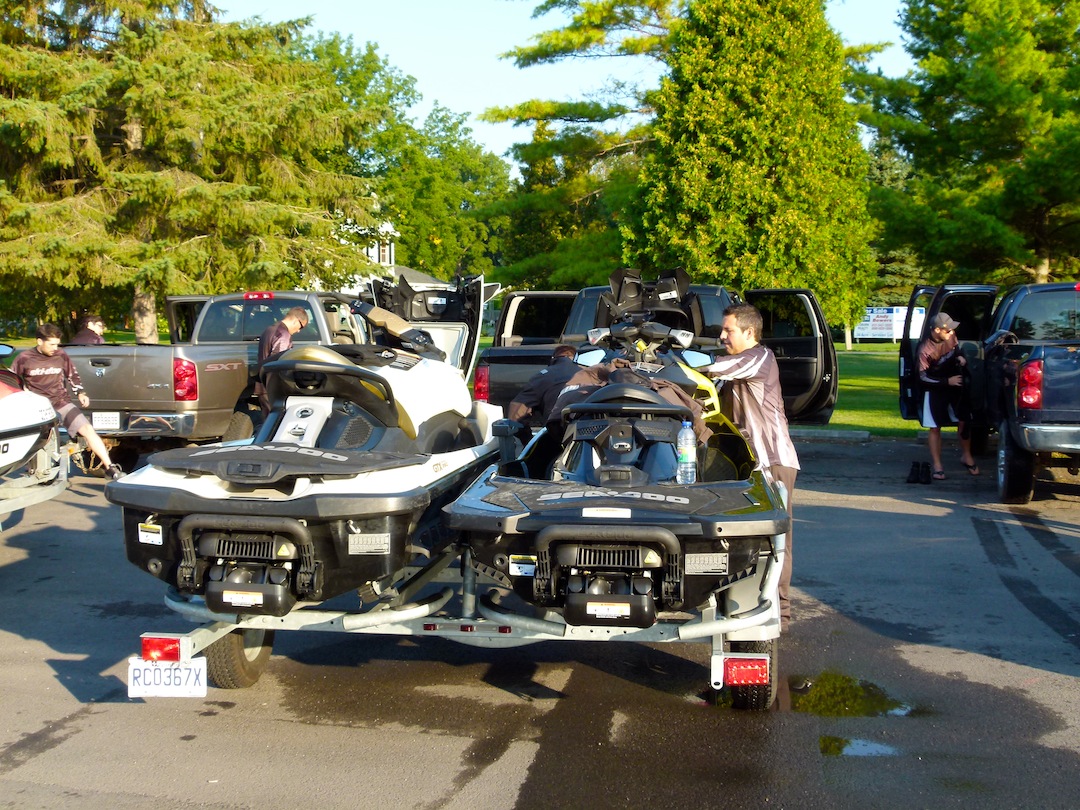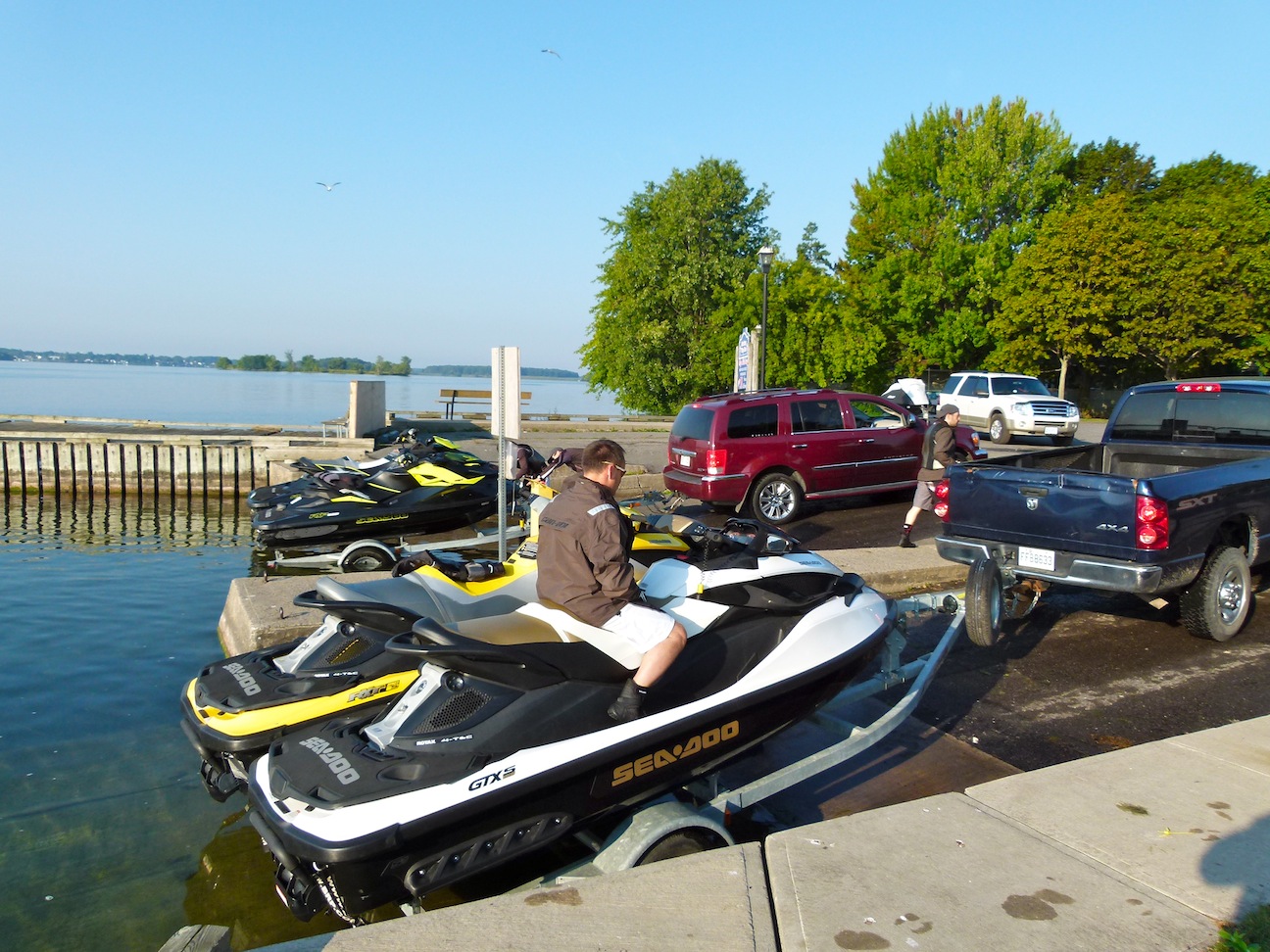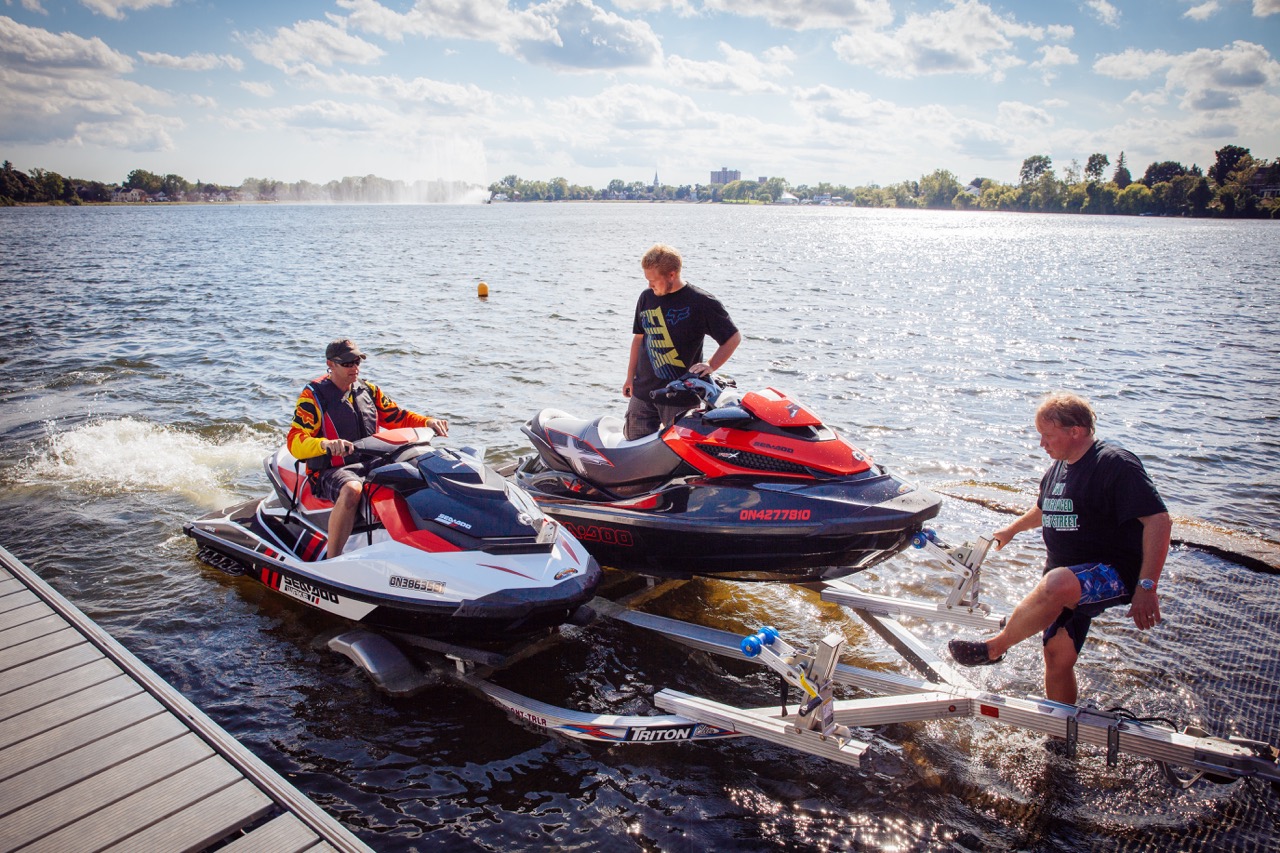Tips for Jet Ski Towing & Launching…
Related: Other Launching Lessons
Towing and launching Sea Doo watercraft is easy for either experienced jet ski riders or PWC beginners. In fact, it hardly feels like I’m towing a PWC Triton trailer on Sea Doo tour or other PWC adventures riding a Sea Doo, jet ski or waverunner personal watercraft in Ontario. Neither one or two-bed PWC Triton trailers restrict rearward sight lines like towing a large boat or snowmobile trailer does. And I can keep an eye on the jet skis and covers with my rearview mirrors.
Securing the front of my Sea Doo watercraft is easy on a Triton Trailer, using the hook and winch. Just be sure to run the winch strap under the rubber stopper and between the metal side supports. Then hook the end of the strap through the bow eyelet on the front of your jet ski. The bow should rest firmly against the rubber stopper above this eyelet. Then, before moving, check to make sure the winch locking lever is engaged.

Proper hook up for trailer winch strap.
At the back, I use high quality tie downs to fasten my Sea Doo watercraft to the PWC trailer. Then I cover up with a perfectly fitted Sea Doo cover to protect my jet ski from dirt, bug splats, stone chips and prying eyes. I have many more Sea Doo riding tips, but this one’s all about towing and launching Sea Doo watercraft…
Towing and Launching: Sea Doo & Jet Ski Launching Prep…
Launching my Sea Doo watercraft for jet skiing is also easy. If I have it, I slip my tow vehicle into 4-wheel drive at the launch. Before launching, I unplug the PWC trailer’s electrical hook up and check that the watercraft drain plugs are tight. I always start my Sea Doo watercraft briefly on the trailer. I don’t leave them running long to prevent engine damage. But this quick check helps ensure that I’m not launching a malfunctioning jet ski (making it much more difficult to re-load). It also serves to make sure I have the right DESS cord(s) before I launch.
Towing and Launching: Sea Doo & Jet Ski Launch Inspection…
Before backing in, I get out and do a quick visual inspection of the boat launch area. This includes under water, checking for bumps, cracks, obstacles or any other irregularities that might prevent with a smooth launch, or damage my Sea Doo watercraft or tow vehicle. Or interfere with re-loading onto my jet ski trailer later. I pay special attention to the steepness and surface of the launch, as an unexpectedly sharp decline or slippery surface can make getting in and out more difficult.
I also note the water depth to ensure my Sea Doo watercraft will float free without my having to back halfway across the lake. Or inadvertently flood the inside of my tow vehicle. At one too-shallow launch, I had quite a workout manhandling the Sea Doo watercraft off the PWC trailer! Tip: I’ve bent several low hanging trailer licence plates while launching and even lost one. So now I remove the bolts holding the plate stiffly in place. Instead, I affix it with very heavy-duty zip ties so that it swings and moves out of the way when it hits bottom.
Towing and Launching: Launching Sea Doo or Jet Ski With 2 People…
For a two-person jet ski launch, I remove all the rear tie downs before backing up until the PWC trailer is on the launch, but not in the water. Then I unfasten the front hook from one unit so that watercraft is no longer attached to the trailer. My companion then climbs on to the jet ski trailer and aboard the loose watercraft without getting wet. And then I back in far enough that the one Sea Doo floats free so the jet ski rider can start up, back out and dock it. If there’s a second personal watercraft, I pull ahead and repeat the process.
Towing and Launching: Launching Sea Doo or Jet Ski by Yourself…
If I’m alone for the launch, the process is much the same. Except I use the front mooring line to tie the loose jet ski to the PWC trailer so it doesn’t float way before I can get back to it from behind the wheel. Then I either climb on and back it away. Or simply walk the Sea Doo free of the PWC trailer from dry land using the mooring line (one reason why it’s important to have a long one). As a precaution, it’s also a good idea to set your vehicle’s parking brake before you get out to launch your jet ski.
Towing and Launching: Loading Up Sea Doo or Jet Ski…
To re-load my Sea Doo watercraft after jet skiing, I basically the reverse process. First, I ensure that the PWC trailer bunks are in the proper position, not flipped out of place. Then I back in so that the ends of the bunks are covered by water. But the rest of their length is not. This helps ensure that even if my approach on to the trailer is a little crooked, the above-the-water bunks guide the personal watercraft on to make sure each is properly settled and centred. (If the bunks are all under water, the jet ski can float too much and not settle properly in place.) I re-fasten the front hook(s), then get back in my vehicle and release the parking brake before pulling out of the water to put the rear tie-downs tightly in place. It’s also important for me to remember to re-connect the jet ski railer electrical hook up and go back to 2-wheel drive before driving away.
Towing and Launching: Two More Sea Doo and Jet Ski Launch Tips…
Go slow and easy at every launch. Having burst a tire pulling out too fast and seen one guy drop his improperly secured jet ski on a concrete ramp (ouch!) when the PWC trailer jerked ahead, I’ve learned that easing into and out of the water slowly is a much safer way to go. So learn from my Sea Doo trailering mistakes!
Finally, leave your PWC trailer wheels (or tow vehicle wheels) sitting in the water for as short a time as possible. Because getting wet can soak the bearings, brakes, etc, possibly causing malfunction, and certainly rust, corrosion and earlier need for repairs. Happy towing and launching!
Check Out My Favourite Boat Launches!
If you enjoyed this post, check out my other riding tips.
The tips and advice in this article are the opinions of the author, may not work in every situation and are intended only for the convenience and interest of the reader, who has the personal responsibility to confirm the validity, accuracy and relevancy of this information prior to putting it to their own use.




